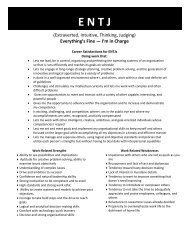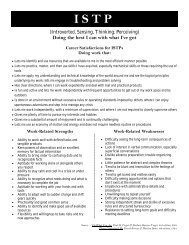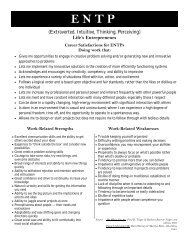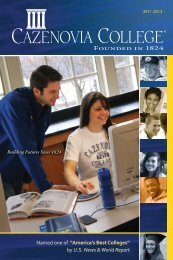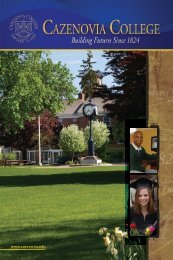of
2013-14 Academic Catalog - Cazenovia College
2013-14 Academic Catalog - Cazenovia College
- No tags were found...
Create successful ePaper yourself
Turn your PDF publications into a flip-book with our unique Google optimized e-Paper software.
SM 164 Visual Mathematics<br />
3 credits (AS)<br />
This course familiarizes students with fundamental properties<br />
<strong>of</strong> two and three dimensional geometric shapes and fosters an<br />
appreciation for the usefulness <strong>of</strong> geometry, with an emphasis<br />
on design through a projects based approach. Topics include:<br />
problem solving; geometric shapes and measurement;<br />
perimeter, area and volume; similarity; coordinate and<br />
transformation geometry; and Escher tessellations.<br />
SM 165 Pre-Calculus<br />
3 credits (AS)<br />
This course provides students with a thorough understanding<br />
<strong>of</strong> the mathematical concepts and skills needed as prerequisite<br />
for Calculus I. Emphasis is placed on developing<br />
mathematical reasoning and graphical visualization skills, thus<br />
helping students understand how the mathematical concepts<br />
can be applied to solve real world problems. Topics studied<br />
include graphs, functions, exponential and logarithmic<br />
functions, trigonometric functions, and matrices. (Offered fall<br />
and spring term) Prerequisite: Successful completion <strong>of</strong> mathematics<br />
placement exam or equivalent or permission <strong>of</strong> the instructor.<br />
SM 211 Investigating Biology<br />
3 credits (AS)<br />
Students are introduced to a variety <strong>of</strong> commonly used field<br />
and laboratory techniques for investigating biological topics.<br />
Emphasis is placed on hypothesis development, sample<br />
methodology and data collection, and the basics <strong>of</strong> data<br />
analysis, interpretation and presentation. Does not fulfill the<br />
lab science requirement. (Offered spring term) Pre-requisite:<br />
SM 117 or SM 118<br />
SM 215 Equine Anatomy and Physiology<br />
4 credits (CS/AS)<br />
The course familiarizes students with the skeletal structure,<br />
musculature and internal systems <strong>of</strong> the horse, including the<br />
nervous, circulatory, respiratory, digestive, integumentary,<br />
special senses and reproductive systems. The course structure<br />
includes three lectures and one laboratory session each week.<br />
This course fulfills the lab science requirement in the general<br />
education core. (Offered fall term) Prerequisite: SM 117 or SM<br />
118.y.<br />
SM 219 Aquatic Biology<br />
4 credits (AS)<br />
The physical and biological aspects <strong>of</strong> aquatic ecosystems are<br />
investigated. Topics include the types <strong>of</strong> major freshwater<br />
habitats (ponds, lakes, rivers, bogs and swamps) and the<br />
physiological and behavioral adaptations <strong>of</strong> animals and<br />
plants in each <strong>of</strong> these habitats. The laboratory portion<br />
consists <strong>of</strong> field trips to various habitats, analysis <strong>of</strong> the<br />
physical factors, and determination <strong>of</strong> species present.<br />
(Offered irregularly). Prerequisite: SM 117 or SM 140.<br />
SM 221 Organic Chemistry I<br />
4 credits (AS)<br />
This class focuses on a study <strong>of</strong> carbon-containing<br />
compounds upon which living things are based. It deals with<br />
the structure, bonding and reactivity <strong>of</strong> compounds that<br />
contain mainly carbon and hydrogen. Emphasis is placed on<br />
understanding relationships between molecular structure and<br />
properties and on designing syntheses <strong>of</strong> organic compounds.<br />
The use <strong>of</strong> spectroscopy in determining the molecular<br />
structure will be included as well. The laboratory provides<br />
hands-on experience with the tools and techniques <strong>of</strong> organic<br />
chemistry. Fulfills the lab science requirement. (Offered fall<br />
term, alternate years) Prerequisite: SM 121 General Chemistry I<br />
and SM 122 General Chemistry II.<br />
SM 222 Organic Chemistry II<br />
4 credits (AS)<br />
This course is a continuation <strong>of</strong> Organic Chemistry I with<br />
emphasis on mon<strong>of</strong>unctional and polyfunctional organic<br />
compounds and multi-step methods <strong>of</strong> synthesis. Fulfills the<br />
lab science requirement. (Offered spring term, alternate years)<br />
Prerequisite: SM 221 Organic Chemistry I<br />
SM 224 General Zoology<br />
4 credits (AS)<br />
This course is a survey <strong>of</strong> the animal kingdom, covering<br />
major invertebrate and vertebrate groups. Emphasis is placed<br />
on structural and functional relationships related to evolution<br />
and physiology. Lab exercises compare these relationships<br />
among diverse taxonomic groups. Fulfills the lab science<br />
requirement. (Offered alternate years)<br />
SM 225/325 Plant Biology<br />
4 credits (AS)<br />
Students explore in more depth the morphology, anatomy,<br />
development, metabolism, physiology and evolution <strong>of</strong> plants<br />
and their traditionally linked allies, the bacteria and fungi.<br />
Additionally topics emphasize plant domestication and<br />
economic/ecological importance. Fulfills the lab science<br />
requirement. (Offered spring term) Pre-requisite: SM 117 or SM<br />
118<br />
SM 231 Comparative Vertebrate Anatomy<br />
4 credits (AS)<br />
Students investigate the basic anatomy and histology <strong>of</strong> the<br />
principle organ systems <strong>of</strong> vertebrates with a focus on<br />
comparing the structural variation and adaptations with<br />
respect to taxonomy, evolution and ecological relationships.<br />
Lab is integrated with lectures. (Offered alternate years) Prerequisite:<br />
SM 117 or SM 224<br />
SM 243/343 BioTopics<br />
3 credits (AS)<br />
This course serves as a spring entry-level course for the<br />
biology program. As such, the topics vary by instructor and<br />
year. Example topics include, but are not limited to, forest<br />
ecology, invasive species, oceans, seeds <strong>of</strong> change, and<br />
biology <strong>of</strong> parasites. Those students taking the course for<br />
300-level credit must cover and complete additional material<br />
and assignments. Does not fulfill the lab science requirement.<br />
(Offered spring term)<br />
Academic Catalog | Cazenovia College | www.cazenovia.edu 176




